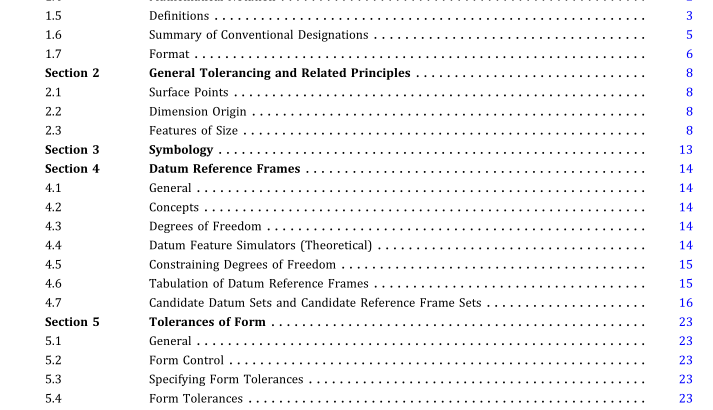ASME Y14.5.1-2019 pdf free download.Mathematical Definition of Dimensioning and Tolerancing Principles
2.1 SURFACE POINTS This Standard describes the relationship between points on the surface of a part and mathematically defined tolerance zones. In order to effectively apply mathematics to these relationships, it is assumed that the location of the points on the surface are known exactly and it is also known to which feature each point belongs.
NOTES: (1) The definition of what constitutes an “actual surface,” whether on an atomic scale or some other scale, is not addressed in this Standard. What constitutes an “actual surface” may vary by industry and application. (2) The assignment of points to specific features is known as partitioning. This process is not addressed in this Standard.
2.2 DIMENSION ORIGIN When a dimension origin symbol is used to specify the distancebetweentwo features, the featurefromwhichthe dimension originates defines an origin plane for defining the tolerance zone. In such cases, the origin plane shall be established using the same rules as are provided for primary datum features (although a datum is not created). See Section 4, Datum Reference Frames.
2.3 FEATURES OF SIZE Features ofsize are classified as regular, irregular (type a),orirregular(type b). Theseare abbreviatedFOS, IFOSa, or IFOSb for ease of notation. Per ASME Y14.5-2009 Regular feature of size: one cylindrical or spherical surface, acircularelement, andasetoftwoopposedparallel elementsoropposedparallelsurfaces, each ofwhich isasso- ciated with a directly toleranced dimension. [1.3.32.2] Circularelements and opposedparallel elements canbe considered[regular] “elements ofsize” whendefinedwith appropriate cutting surface (see para. 1.5.7). PerASME Y14.5-2009, an IFOSa is “a directlytoleranced feature or collection offeatures that may contain or be contained by an actual mating envelope that is a sphere, cylinder, or pair of parallel planes.” [1.3.32.2(a)] See Figure 2-1.
NOTE: For an IFOSa, the actual mating envelope is explicitly defined by the Engineering Data. For example, supplemental geometrydefiningacylinderorparallel planes is neededto iden- tify the feature of size in Figure 2-1. PerASME Y14.5-2009, an IFOSb is “a directlytoleranced feature or collection offeatures that may contain or be contained by an actual mating envelope other than a sphere, cylinder, or pair ofparallel planes.” [1.3.32.2(b)] See Figure 2-6. This subsection establishes definitions for the size limits, conformance, and actual size value for features of size. Subject to Rule #1 of ASME Y14.5-2009 [2.7.1], size limits of regular features of size also control form variation. The method by which Rule #1 is applied is discussed in para.
2.3.2.1. For the definition of form controls, refer to Section 5.
2.3.1 Limits of Size Size is the value used to characterize a feature ofsize. A size tolerance describes both upper and lower limits for this parameter. A feature ofsize satisfies its size tolerance if the feature is contained within a tolerance zone corre- sponding to these limits. Paragraphs 2.3.1 through 2.3.4 are applicable for regular features ofsize and IFOSa; para.
2.3.5 applies to IFOSb. (a) Definition. A size tolerance zone is the volume between two half-space boundaries, to be described below. The tolerance zone does not have a unique form. Each half-space boundary is formed by sweeping a ball of appropriate radius along an acceptable spine, as discussed below. The radii ofthe balls are determined by the size limits: one ball radius is the least material condition limit (r LMC ) and one is the maximum material condition limit (r MMC ). A zero-dimensional spine is a point, and applies to spherical features.
A one-dimensional spine is a simple (non-self-intersecting) curve in space, and applies to cy- lindrical features. A two-dimensional spine is a simple (non-self-intersecting) surface, and applies to parallel- plane features. These three types of spines can be more rigorously defined, respectively, as connected regular (in the relative topology) subsets of d-manifolds, ford= 0, 1, and2. Ad-dimensionalspine willbedenotedas S d . Also, a (solid) ball of radius r will be denoted as B r . ASME Y14.5.1 pdf download.ASME Y14.5.1-2019 pdf free download
